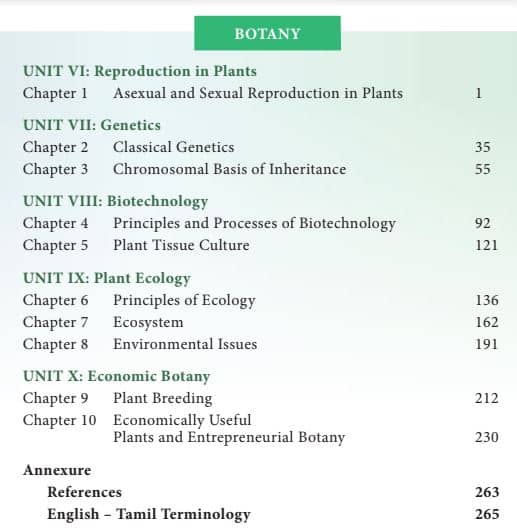‘Botany Class 12th’ PDF Quick download link is given at the bottom of this article. You can see the PDF demo, size of the PDF, page numbers, and direct download Free PDF of ‘Class 12 Botany Textbook’ using the download button.
12th Botany Book PDF Free Download

UNIT VI: Reproduction in Plants
Chapter 1 Asexual and Sexual Reproduction in Plants
UNIT VII: Genetics
Chapter 2 Classical Genetics
Chapter 3 Chromosomal Basis of Inheritance
UNIT VIII: Biotechnology
Chapter 4 Principles and Processes of Biotechnology
Chapter 5 Plant Tissue Culture
UNIT IX: Plant Ecology
Chapter 6 Principles of Ecology
Chapter 7 Ecosystem
Chapter 8 Environmental Issues
UNIT X: Economic Botany
Chapter 9 Plant Breeding
Chapter 10 Economically Useful
Plants and Entrepreneurial Botany
Asexual Reproduction
The reproduction method which helps to perpetuate its own species without the involvement of gametes is referred to as asexual reproduction. From Unit I of Class XI we know that reproduction is one of the attributes of living things and the different types of reproduction have also been discussed. Lower plants, fungi, and animals show different methods of asexual reproduction. Some of the methods include the formation of Conidia (Aspergillus and Penicillium); Budding (Yeast and Hydra); Fragmentation (Spirogyra); production of Gemma (Marchantia); Regeneration (Planaria)
1.2 Vegetative reproduction
1.2.1 Natural methods
Natural vegetative reproduction is a form of asexual reproduction in which a bud grows and develops into a new plant. The buds may be formed in organs such as root, stem, and leaf.
At some stage, the new plant gets detached from the parent plant and starts to develop into a new plant. Some of the organs involved in vegetative reproduction also serve as the organs of storage and perennation.
The unit of reproductive structure used in propagation is called reproductive propagules or diaspores.
| Author | Government |
| Language | English |
| No. of Pages | 320 |
| PDF Size | 121 MB |
| Category | Education |
Related PDFs
TS 9th Class Telugu Textbook PDF
IELTS Exam Sample Question Paper 2023 PDF
D.El.Ed Text Book PDF In Malayalam
Tamilnadu Board 12th Botany Text Book PDF 2023 Download
12th Botany Book PDF Free Download
